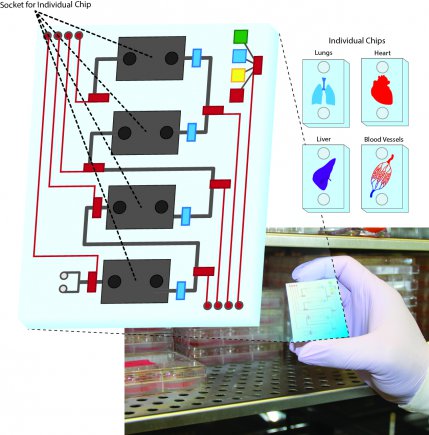Human on a chip
October 1, 2013

(Credit: U.S. Army)
The “human on a chip” research focuses on in vitro human organ constructs (for the heart, liver, lung and the circulatory system) in communication with each other. The goal is to assess effectiveness and toxicity of drugs in a way that is relevant to humans and their ability to process these drugs.
“The screening models will be used to assess the efficacy and safety of medical mitigation procedures and countermeasures for the soldier and the nation as a whole,” said Dr. Harry Salem, ECBC’s chief scientist for Life Sciences.
Each organ-on-a-chip is about the size of a thumb drive and is an “organoid” (a structure that resembles an organ in appearance or function), designed to mimic the properties of an actual human organ.
The organoids are created by induced pluripotent stem cells made from adult skin cells. They comprise multiple layers of cells growing on a membrane, connected to each other by microfluidics (tiny micro channels) that copy the function of blood vessels.
Their primary purpose is to take the place of animal research. According to Salem, compounds quite often behave differently in people than they do in animals. For that reason, human-estimate studies are used, but do not always accurately reflect the human response. Due to the species-specific differences by which compounds are metabolized, a drug tested on a laboratory rat doesn’t always translate well to a human.
In some cases, no animal testing can mimic the human response. Asthma, for example, is a uniquely human disease. Since human-on-a-chip is made from human cells, it is the next best thing. Human tissue reacts like human tissue.
New predictive models of toxicity
The researchers anticipate that new predictive models of toxicity will result from the more accurate human-on-a-chip testing, saving time and money. Pharmaceuticals tested on animals fail to work on humans 90 percent of the time. This technology will result in fewer test failures. Scientists will be able to narrow their research efforts by identifying which therapeutics will be effective or fail early on in the testing process, the researchers say.
The center houses the only laboratories in the United States that the Chemical Weapons Convention permits to produce chemical warfare agent for testing purposes. ECBC will test the human-on-a-chip against chemical warfare agents to learn more about how the body will respond to agent exposure and explore various treatment options for exposures.
“The human-on-a-chip promises to accelerate the pace of research and consequently scientific breakthroughs,” Dr. Russell Dorsey, a research microbiologist and one of the members performing the in vitro testing at ECBC, said. “For the military, our human-on-a-chip research will save actual warfighters’ lives.”
The center will be collaborating with the U.S. Army Medical Research Institute of Chemical Defense, Wake Forest, Harvard, and the University of Michigan on the chip design.
The five-year research project is funded by the Defense Threat Reduction Agency.
(¯`*• Global Source and/or more resources at http://goo.gl/zvSV7 │ www.Future-Observatory.blogspot.com and on LinkeIn Group's "Becoming Aware of the Futures" at http://goo.gl/8qKBbK │ @SciCzar │ Point of Contact: www.linkedin.com/in/AndresAgostini
 Washington
Washington